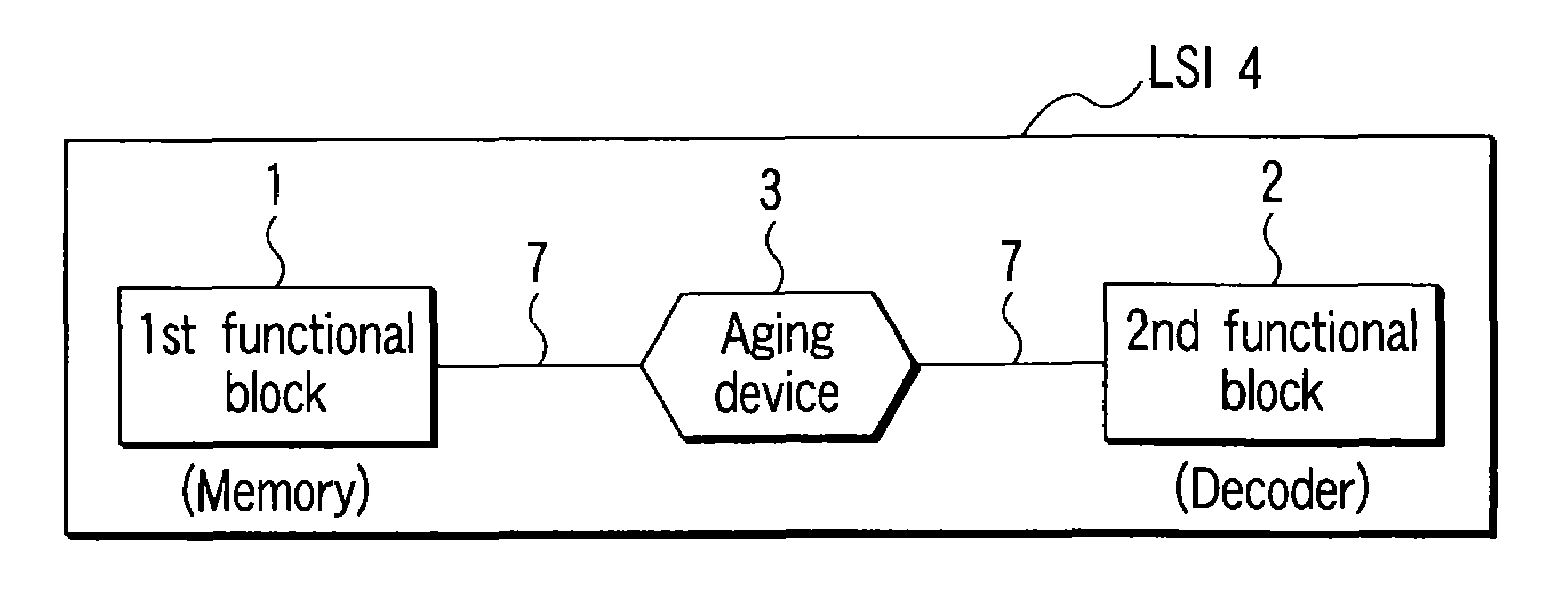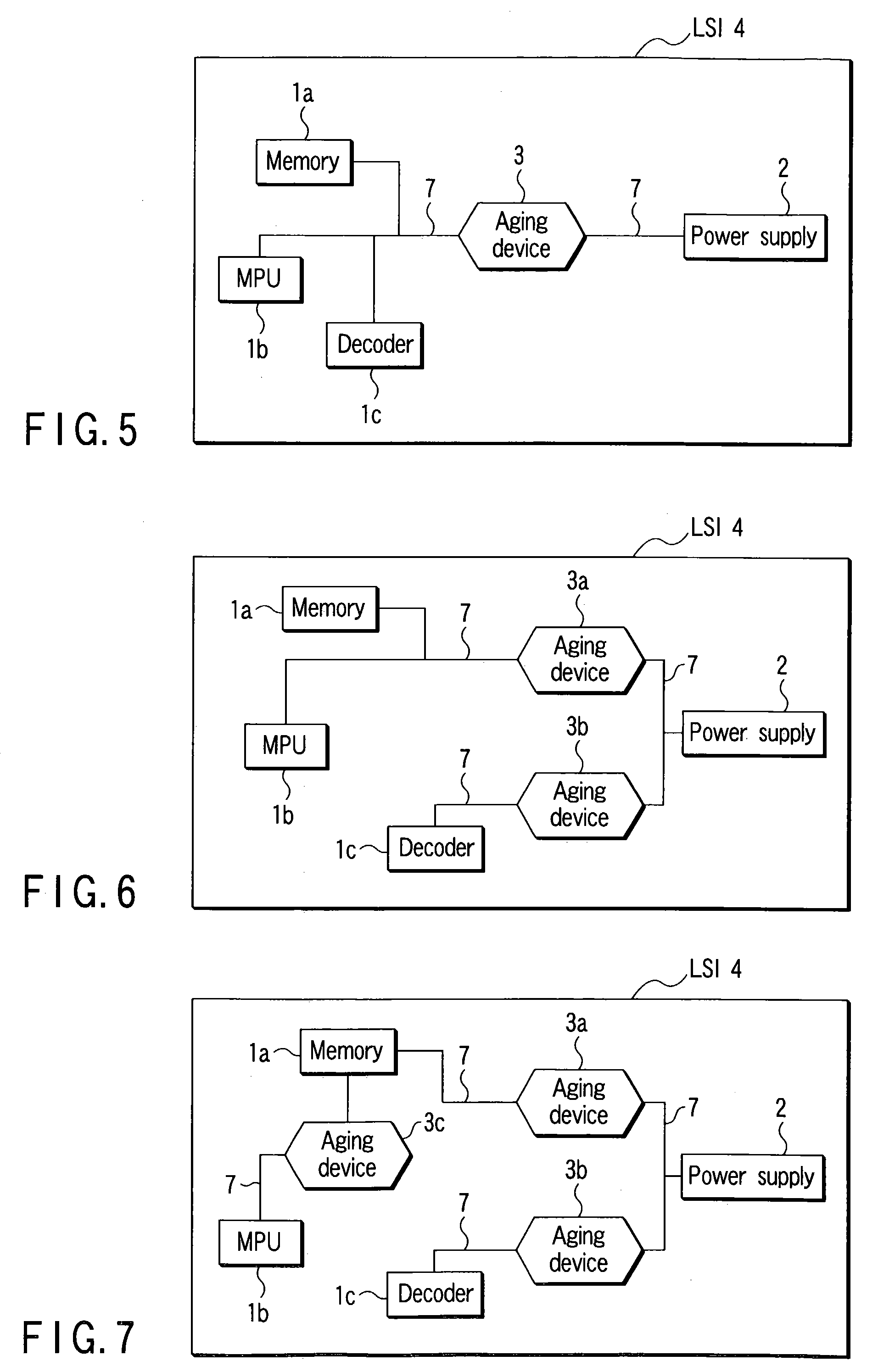Time limit function utilization
a function and function technology, applied in the field of time limit function utilization apparatus, can solve the problems of large difference in life time, complicated manufacturing method, and difficulty in reproducing accurate holding life tim
- Summary
- Abstract
- Description
- Claims
- Application Information
AI Technical Summary
Problems solved by technology
Method used
Image
Examples
first embodiment
[0170]As shown in FIG. 1, the first embodiment comprises an integrated circuit (LSI) 4 in which a memory area (memory) serving as the first functional block 1, a decoder which serves as the second functional block 2 and reads out information from the memory area, and a semiconductor time switch (automatic turn-off aging device) 3 which is connected between the memory 1 and the decoder 2 via the signal line 7 and turned off upon the lapse of a predetermined time are integrated.
[0171]As shown in FIG. 1, the aging device 3 is interposed between the memory 1 and the decoder 2. In this case, one terminal of the aging device 3 is connected to the memory 1, and the other terminal is connected to the decoder 2. The decoder 2 and memory 1 can access each other.
[0172]The aging device 3 is turned off upon the lapse of a predetermined time, and the memory 1 and decoder 2 are disconnected from each other. The decoder 2 cannot access the memory 1, and the LSI 4 malfunctions. For example, when the...
second embodiment
[0173]As shown in FIG. 2, the second embodiment comprises an integrated circuit (LSI) 4 in which an operational area (MPU) 1 serving as the first functional block, a decoder 2 serving as the second functional block, and a semiconductor time switch (aging device) 3 which is connected between the MPU 1 and the decoder 2 via the signal line 7 and turned off upon the lapse of a predetermined time are integrated.
[0174]As shown in FIG. 2, the aging device 3 is interposed between the MPU 1 and the decoder 2. In this case, one terminal of the aging device 3 is connected to the MPU 1, and the other terminal is connected to the decoder 2. The MPU 1 and decoder 2 can access each other.
[0175]The aging device 3 is turned off upon the lapse of a predetermined time, and the MPU 1 and decoder 2 are disconnected from each other. The MPU 1 and decoder 2 cannot access each other, and the LSI 4 malfunctions. For example, encryption information decrypted by the MPU 1 cannot be read by the decoder 2, and...
third embodiment
[0176]As shown in FIG. 3, the third embodiment comprises an integrated circuit (LSI) 4 in which an operational area (MPU) 1 serving as the first functional block, a memory area (memory) 2 serving as the second functional block, and a semiconductor time switch (aging device) 3 which is connected between the MPU 1 and the memory 2 via the signal line 7 and turned off upon the lapse of a predetermined time are integrated.
[0177]As shown in FIG. 3, the aging device 3 is interposed between the MPU 1 and the memory 2. In this case, one terminal of the aging device 3 is connected to the MPU 1, and the other terminal is connected to the memory 2. The MPU 1 and memory 2 can access each other.
[0178]The aging device 3 is turned off upon the lapse of a predetermined time, and the MPU 1 and memory 2 are disconnected from each other. The MPU 1 and memory 2 cannot access each other, and the LSI 4 malfunctions. For example, the MPU 1 cannot read a decryption key stored in the memory 2, and a time li...
PUM
 Login to View More
Login to View More Abstract
Description
Claims
Application Information
 Login to View More
Login to View More - R&D
- Intellectual Property
- Life Sciences
- Materials
- Tech Scout
- Unparalleled Data Quality
- Higher Quality Content
- 60% Fewer Hallucinations
Browse by: Latest US Patents, China's latest patents, Technical Efficacy Thesaurus, Application Domain, Technology Topic, Popular Technical Reports.
© 2025 PatSnap. All rights reserved.Legal|Privacy policy|Modern Slavery Act Transparency Statement|Sitemap|About US| Contact US: help@patsnap.com



